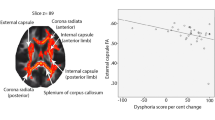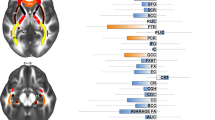Abstract
Skin picking disorder (SPD) is characterized by the repetitive and compulsive picking of skin, resulting in tissue damage. Neurocognitive findings in SPD implicate difficulty with response inhibition (suppression of pre-potent motor responses). This function is dependent on the integrity of the right frontal gyrus and the anterior cingulate cortices, and white-matter tracts connecting such neural nodes. It was hypothesized that SPD would be associated with reduced fractional anisotropy in regions implicated in top-down response suppression, particularly white-matter tracts in proximity of the bilateral anterior cingulate and right frontal (especially orbitofrontal and inferior frontal) cortices. 13-subjects meeting proposed SPD criteria for DSM-5 free from other current psychiatric comorbidities, and 12 healthy comparison subjects underwent MRI with a 3-T system. Between-group comparisons of imaging data underwent voxelwise analysis with permutation modeling and cluster correction. Fractional anisotropy (measured using diffusion tensor imaging) was the primary outcome measure. Subjects with SPD exhibited significantly reduced fractional anisotropy in tracts distributed bilaterally, which included the anterior cingulate cortices. Fractional anisotropy did not correlate significantly with SPD disease severity, or depressive or anxiety scores. These findings implicate disorganization of white-matter tracts involved in motor generation and suppression in the pathophysiology of SPD, findings remarkably similar to those previously reported in trichotillomania. This study adds considerable support to the notion that—in addition to the phenomenological and comorbid overlap between SPD and trichotillomania—these disorders likely share overlapping neurobiology.
Similar content being viewed by others

Log in or create a free account to read this content
Gain free access to this article, as well as selected content from this journal and more on nature.com
or
References
American Psychiatric Association (2000). Diagnostic and Statistical Manual of Mental Disorders Text Revision, 4th edn. Washington, DC.
Andersson JLR, Jenkinson M, Smith S (2007). . Non-linear optimisation. FMRIB technical report TR07JA1 from www.fmrib.ox.ac.uk/analysis/techrep.
Arnold LM, Auchenbach MB, McElroy SL (2001). Psychogenic excoriation. Clinical features, proposed diagnostic criteria, epidemiology and approaches to treatment. CNS Drugs 15: 351–359.
Arnold LM, Mutasim DF, Dwight MM, Lamerson CL, Morris EM, McElroy SL (1999). An open clinical trial of fluvoxamine treatment of psychogenic excoriation. J Clin Psychopharmacol 19: 15–18.
Beaulieu C (2002). The basis of anisotropic water diffusion in the nervous system: a technical review. NMR Biomed 15: 435–455.
Bienvenu OJ, Samuels JF, Wuyek LA, Liang KY, Wang Y, Grados MA et al (2012). Is obsessive-compulsive disorder an anxiety disorder, and what, if any, are spectrum conditions? A family study perspective. Psychol Med 42: 1–13.
Bullmore ET, Suckling J, Overmeyer S, Rabe-Hesketh S, Taylor E, Brammer MJ (1999). Global, voxel, and cluster tests, by theory and permutation, for a difference between two groups of structural MR images of the brain. IEEE Trans Med Imaging 18: 32–42.
Bush G, Shin LM, Holmes J, Rosen BR, Vogt BA (2003). The Multi-Source Interference Task: validation study with fMRI in individual subjects. Mol Psychiatry 8: 60–70.
Chamberlain SR, Hampshire A, Menzies LA, Garyfallidis E, Grant JE, Odlaug BL et al (2010). Reduced brain white matter integrity in trichotillomania: a diffusion tensor imaging study. Arch Gen Psychiatry 67: 965–971.
Chamberlain SR, Menzies L (2009). Endophenotypes of obsessive-compulsive disorder: rationale, evidence and future potential. Expert Rev Neurother 9: 1133–1146.
Chambers CD, Garavan H, Bellgrove MA (2009). Insights into the neural basis of response inhibition from cognitive and clinical neuroscience. Neurosci Biobehav Rev 33: 631–646.
Chen SK, Tvrdik P, Peden E, Cho S, Wu S, Spangrude G et al (2010). Hematopoietic origin of pathological grooming in Hoxb8 mutant mice. Cell 141: 775–785.
Feusner JD, Hembacher E, Phillips KA (2009). The mouse who couldn't stop washing: pathologic grooming in animals and humans. CNS Spectr 14: 503–513.
First MB, Spitzer RL, Gibbon M, Williams JBW (1995) Structured Clinical Interview for DSM-IV-Patient Edition (SCID-I/P, Version 2.0). Biometrics Research Department, New York State Psychiatric Institute: New York, NY.
Flessner CA, Woods DW (2006). Phenomenological characteristics, social problems, and the economic impact associated with chronic skin picking. Behav Modif 30: 944–963.
Grant JE, Odlaug BL, Chamberlain SR, Keuthen NJ, Lochner C, Stein DJ (2012). Skin picking disorder: an under-recognized and under-treated disorder. Am J Psychiatry 169: 1143–1149.
Grant JE, Odlaug BL, Chamberlain SR (2011). A cognitive comparison of pathological skin picking and trichotillomania. J Psychiatr Res 45: 1634–1638.
Grant JE, Odlaug BL, Kim SW (2007). Lamotrigine treatment of pathologic skin picking: an open-label study. J Clin Psychiatry 68: 1384–1391.
Greer JM, Capecchi MR (2002). Hoxb8 is required for normal grooming behavior in mice. Neuron 33: 23–34.
Guy W (1976) ECDEU assessment manual for psychopharmacology. US Department of Health, Education and Welfare publication (ADM) 76-338. National Institute of Mental Health: Rockville. pp 218–222.
Hamilton M (1959). The assessment of anxiety states by rating. Br J Med Psychiatry 32: 50–55.
Hamilton M (1960). A rating scale for depression. J Neurol Neurosurg Psychiatry 23: 56–62.
Hyman SE (2010). A bone to pick with compulsive behavior. Cell 141: 752–754.
Keuthen NJ, Koran LM, Aboujaoude E, Large MD, Serpe RT (2010). The prevalence of pathological skin picking in US adults. Compr Psychiatry 51: 183–186.
Kondziolka D, Hudak R (2008). Management of obsessive-compulsive disorder-related skinpicking with gamma knife radiosurgical anterior capsulotomies: a case report. J Clin Psychiatry 69: 1337–1340.
Murray EA, O'Doherty JP, Schoenbaum G (2007). What we know and do not know about the functions of the orbitofrontal cortex after 20 years of cross-species studies. J Neurosci 27: 8166–8169.
Neziroglu F, Rabinowitz D, Breytman A, Jacofsky M (2008). Skin picking phenomenology and severity comparison. Prim Care Companion J Clin Psychiatry 10: 306–312.
Nichols TE, Holmes AP (2002). Nonparametric permutation tests for functional neuroimaging: a primer with examples. Hum Brain Mapp 15: 1–25.
Odlaug BL, Chamberlain SR, Grant JE (2010). Motor inhibition and cognitive flexibility in pathologic skin picking. Prog Neuropsychopharmacol Biol Psychiatry 34: 208–211.
Odlaug BL, Grant JE (2008a). Clinical characteristics and medical complications of pathologic skin picking. Gen Hosp Psychiatry 30: 61–66.
Odlaug BL, Grant JE (2008b). Trichotillomania and pathological skin picking: clinical comparison with an examination of comorbidity. Ann Clin Psychiatry 20: 57–63.
Odlaug BL, Grant JE (2012). Pathologic skin picking. In: Grant JE, Stein DJ, Woods DW, Keuthen NJ, (eds). Trichotillomania, Skin Picking and Other Body-Focused Repetitive Behaviors. American Psychiatric Publishing, Inc: Washington, DC. pp 21–41.
Odlaug BL, Lust K, Schreiber LRN, Christenson GA, Derbyshire K, Grant JE (2012). Skin picking disorder: Health correlates and gender differences. Gen Hosp Psychiatry pii: S0163-8343: 00269–1.
Ridderinkhof KR, van den Wildenberg WP, Segalowitz SJ, Carter CS (2004). Neurocognitive mechanisms of cognitive control: the role of prefrontal cortex in action selection, response inhibition, performance monitoring, and reward-based learning. Brain Cogn 56: 129–140.
Rubia K, Smith AB, Brammer MJ, Taylor E (2003). Right inferior prefrontal cortex mediates response inhibition while mesial prefrontal cortex is responsible for error detection. Neuroimage 20: 351–358.
Rueckert D, Sonoda LI, Hayes C, Hill DL, Leach MO, Hawkes DJ (1999). Nonrigid registration using free-form deformations: application to breast MR images. IEEE Trans Med Imaging 18: 712–721.
Sharp DJ, Bonnelle V, De Boissezon X, Beckmann CF, James SG, Patel MC et al (2010). Distinct frontal systems for response inhibition, attentional capture, and error processing. Proc Natl Acad Sci USA 107: 6106–6111.
Sheehan DV. The Anxiety Disease (1983) Scribner's:. New York.
Smith SM, Jenkinson M, Johansen-Berg H, Rueckert D, Nichols TE, Mackay CE et al (2006). Tract-based spatial statistics: voxelwise analysis of multi-subject diffusion data. Neuroimage 31: 1487–1505.
Smith SM, Jenkinson M, Woolrich MW, Beckmann CF, Behrens TE, Johansen-Berg H et al (2004). Advances in functional and structural MR image analysis and implementation as FSL. Neuroimage 23 (Suppl 1): S208–S219.
Smith SM (2002). Fast robust automated brain extraction. Hum Brain Mapp 17: 143–155.
Stein DJ, Dodman NH, Borchelt P, Hollander E (1994). Behavioral disorders in veterinary practice: relevance to psychiatry. Compr Psychiatry 35: 275–285.
Suckling J, Davis MH, Ooi C, Wink AM, Fadili J, Salvador R et al (2006). Permutation testing of orthogonal factorial effects in a language-processing experiment using fMRI. Hum Brain Mapp 27: 425–433.
Tucker BT, Woods DW, Flessner CA, Franklin SA, Franklin ME (2011). The Skin Picking Impact Project: phenomenology, interference, and treatment utilization of pathological skin picking in a population-based sample. J Anxiety Disord 25: 88–95.
Wilhelm S, Keuthen NJ, Deckersbach T, Engelhard IM, Forker AE, Baer L, O’Sullivan RL et al (1999). Self-injurious skin picking: clinical characteristics and comorbidity. J Clin Psychiatry 60: 454–459.
Woolrich MW, Jbabdi S, Patenaude B, Chappell M, Makni S, Behrens T et al (2009). Bayesian analysis of neuroimaging data in FSL. Neuroimage 45 (1 Suppl): S173–S186.
Author information
Authors and Affiliations
Corresponding author
Ethics declarations
Competing interests
Dr Grant has received research grant support from NIDA, NCRG, Psyadon Pharmaceuticals, Forest Pharmaceuticals, Transcept Pharmaceuticals, and the University of South Florida. He has also received royalties from American Psychiatric Publishing Inc, Oxford University Press, Norton, and McGraw Hill Publishers. Mr Odlaug has received research grants from the Trichotillomania Learning Center, has consulted for Lundbeck Pharmaceuticals, and reports having received honoraria and royalties from Oxford University Press. Dr Chamberlain has consulted for Cambridge Cognition, P1Vital, Shire, and Lilly. The remaining authors declare no conflict of interest.
PowerPoint slides
Rights and permissions
About this article
Cite this article
Grant, J., Odlaug, B., Hampshire, A. et al. White Matter Abnormalities in Skin Picking Disorder: A Diffusion Tensor Imaging Study. Neuropsychopharmacol 38, 763–769 (2013). https://doi.org/10.1038/npp.2012.241
Received:
Revised:
Accepted:
Published:
Issue date:
DOI: https://doi.org/10.1038/npp.2012.241
Keywords
This article is cited by
-
Atypical cerebellar activity and connectivity during affective touch in adults with skin-picking disorder
Brain Imaging and Behavior (2023)
-
Reward processing in trichotillomania and skin picking disorder
Brain Imaging and Behavior (2022)
-
The Role of the Cerebellum in Skin-Picking Disorder
The Cerebellum (2019)
-
Visual symptom provocation in skin picking disorder: an fMRI study
Brain Imaging and Behavior (2018)
-
Neurocognitive Findings in Onychophagia (Pathological Nail Biting)
Psychiatric Quarterly (2017)


